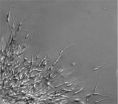(Press-News.org) The best approach to detecting cervical cancer in HIV-positive women living in research limited countries such as those in Sub-Saharan Africa combines commonly used testing methods tailored to local levels of development and medical infrastructure, according to a study by researchers from and the University of Witwatersrand in South Africa and the University of North Carolina.
The research evaluated the effectiveness of three commonly used screening methods– the pap smear, human papillomavirus testing (HPV) and visual inspection of the cervix with acetic acid (VIA) – among 1,202 South African women tested over a period between 2009 and 2011. Led by Cynthia Firnhaber, MD, associate professor of medicine at the University of Witwatersrand and Jennifer Smith, PhD, research associate professor at UNC and member of UNC Lineberger Cancer Center, the study findings were published by PLOS ONE on Jan. 11, 2013.
Invasive cervical cancer is the third most common cancer worldwide in women, and HIV-positive women are at an increased risk for acquiring the disease. In areas such as Africa where HIV infection has become endemic, access to health services greatly increases the chance of detection and survival. Cervical cancer, which is completely preventable, is the leading cause of cancer death in women from Sub-Saharan Africa.
In its earliest stages, invasive cervical cancer begins as pre-cancerous lesions on the cervix known as cervical intraepithelial neoplasia (CIN). Graded on a scale from 1 to 3 by severity, the lesions can take years to progress to an invasive cancer, allowing a large window for screening to be effective and benign legions to be removed.
As stand-alone tests for high-grade CIN, HPV testing proved most sensitive with a 92 percent overall sensitivity, followed by pap smears (76 percent) and VIA (65.5 percent with nurse interpretation rising to 76 percent with physician review). However the specificity of HPV was reduced compared to Pap smears and VIA.
As each of the tests were viable for detecting cervical lesions, the study's authors determined that the decision on which to use must depend on factors such as cost, patient population, availability of skilled medical technicians and laboratory capacity. Using these factors, nations can evaluate which approach will work better for their particular setting, with some benefiting from a mixed approach in different geographical regions within a single country.
"No screening system is perfect and of course we want the best system but the definition of the best and most effective system may vary by the capacity and resources of a location. At present many women are not being screened at all in resource limited countries. We need to be flexible in our approaches to screening so we can reduce the rates of a completely preventable cancer in these countries," said Dr. Firnhaber.
### END
Cervical cancer screening in less-developed areas should be tailored to local conditions
2013-01-14
ELSE PRESS RELEASES FROM THIS DATE:
New discovery in autism-related disorder reveals key mechanism in brain development and disease
2013-01-14
A new finding in neuroscience for the first time points to a developmental mechanism linking the disease-causing mutation in an autism-related disorder, Timothy syndrome, and observed defects in brain wiring, according to a study led by scientist Ricardo Dolmetsch and published online yesterday in Nature Neuroscience. These findings may be at the heart of the mechanisms underlying intellectual disability and many other brain disorders.
The present study reveals that a mutation of the disease-causing gene throws a key process of neurodevelopment into reverse. That is, ...
Smoking, high blood pressure and cholesterol can be fatal for hemorrhage survivors
2013-01-14
"It is particularly important for subarachnoid haemorrhage survivors to refrain from smoking and to take care of their blood pressure and cholesterol levels; apart from age, these are the primary factors behind the increased risk of mortality," explains neurosurgeon Miikka Korja from the HUCH's Neurosurgery Department together with professor Jaakko Kaprio from the University of Helsinki's Hjelt Institute.
The most extensive population-based follow-up study ever carried out on the subject, jointly conducted by HUCH, the University of Helsinki, and the Finnish National ...
Depression after heart attack: Threat perception has to be addressed
2013-01-14
"Survivors of heart attacks are three times more likely to develop depression during the first six months after their heart attack, than people with no heart disease. If left untreated this contributes to a worse prognosis, for instance further cardiac events and possibly death. The causes for this high prevalence of depression after heart attacks are still unclear," said Prof. Claus Vögele, Professor of Clinical and Health Psychology at the University of Luxembourg and lead author of the publication entitled "Cardiac Threat Appraisal and Depression after First Myocardial ...
2 new studies show why biodiversity is important for pollination services in California almond
2013-01-14
Agricultural demand for pollination is growing more quickly than the supply of honey bees, the dominant species managed for crop pollination. Increasing the efficiency of pollination represents a way of increasing crop yield without any increase in agricultural intensity or area. A study recently published in the Proceedings of the Royal Society B: Biological Sciences (9 Jan 2013) 1, shows that the pollination effectiveness of honey bees in California almond orchards was greater in the presence of other bees.
Almond is a crop highly dependent on honey bee pollination ...
How does your garden glow?
2013-01-14
Nature's ability to create iridescent flowers has been recreated by mathematicians at The University of Nottingham. The team of researchers have collaborated with experimentalists at the University of Cambridge to create a mathematical model of a plant's petals to help us learn more about iridescence in flowering plants and the role it may play in attracting pollinators.
An iridescent surface appears to change colour as you alter the angle you view it from. It is found in the animal kingdom in insects, inside sea shells and in feathers, and is also seen in some plants. ...
How do happiness and sadness circuits contribute to bipolar disorder?
2013-01-14
Philadelphia, PA, January 14, 2013 – Bipolar disorder is a severe mood disorder characterized by unpredictable and dramatic mood swings between the highs of mania and lows of depression. These mood episodes occur among periods of 'normal mood', termed euthymia.
Prior research has clearly shown that brain emotion circuitry is dysregulated in individuals diagnosed with bipolar disorder. It is thought that these disturbances impair one's ability to control emotion and contribute to mood episodes.
Continuing this line of research, the January 15th issue of Biological Psychiatry ...
Global warming has increased monthly heat records by a factor of 5
2013-01-14
Monthly temperature extremes have become much more frequent, as measurements from around the world indicate. On average, there are now five times as many record-breaking hot months worldwide than could be expected without long-term global warming, shows a study now published in Climatic Change. In parts of Europe, Africa and southern Asia the number of monthly records has increased even by a factor of ten. 80 percent of observed monthly records would not have occurred without human influence on climate, concludes the authors-team of the Potsdam Institute for Climate Impact ...
Protein identified that can disrupt embryonic brain development and neuron migration
2013-01-14
Interneurons – nerve cells that function as 'dimmers' – play an important role in the brain. Their formation and migration to the cerebral cortex during the embryonic stage of development is crucial to normal brain functioning. Abnormal interneuron development and migration can eventually lead to a range of disorders and diseases, from epilepsy to Alzheimer's. New research by Dr. Eve Seuntjens and Dr. Veronique van den Berghe of the Department of Development and Regeneration (Danny Huylebroeck laboratory, Faculty of Medicine) at KU Leuven (University of Leuven) has identified ...
Research makes connetion between tubal ligation and increase in cervical cancer rates
2013-01-14
Women who have a tubal ligation – the surgical tying or severing of fallopian tubes to prohibit pregnancy – have less frequent Pap smears, which puts them at an increased risk for cervical cancer, according to research recently released by a team that included Cara A. Mathews, MD, a gynecologic oncologist at the Program in Women's Oncology at Women & Infants Hospital of Rhode Island.
The findings were part of the National Cancer Institute-funded study "Study to Understand Cervical Cancer Endpoints and Determinants" being conducted when Dr. Mathews was a fellow at the ...
Liver controls wasting in cancer
2013-01-14
Cachexia or wasting is a condition affecting up to 70 percent of cancer patients, depending on the type of cancer. It is characterized by a dramatic loss of body weight that is independent of food intake. Cachexia is seen particularly often and most pronounced in patients suffering from cancers of the digestive tract and the lungs. They may lose up to 80 percent of body fat and skeletal muscle. Muscle loss leads to weakness and immobility of patients and poorer response to treatment. An estimated 20 percent of cancer deaths are considered to be a direct consequence of cachexia, ...

